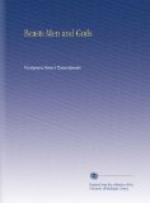At last we left this place of carnage to the cursed god of war. Soon we approached a shallow, rapid stream, where the Mongols slipped from their camels, took off their caps and began drinking. It was a sacred stream which passed beside the abode of the Living Buddha. From this winding valley we suddenly turned into another where a great mountain ridge covered with dark, dense forest loomed up before us.
“Holy Bogdo-Ol!” exclaimed the Lama. “The abode of the Gods which guard our Living Buddha!”
Bogdo-Ol is the huge knot which ties together here three mountain chains: Gegyl from the southwest, Gangyn from the south, and Huntu from the north. This mountain covered with virgin forest is the property of the Living Buddha. The forests are full of nearly all the varieties of animals found in Mongolia, but hunting is not allowed. Any Mongol violating this law is condemned to death, while foreigners are deported. Crossing the Bogdo-Ol is forbidden under penalty of death. This command was transgressed by only one man, Baron Ungern, who crossed the mountain with fifty Cossacks, penetrated to the palace of the Living Buddha, where the Pontiff of Urga was being held under arrest by the Chinese, and stole him.
CHAPTER XXXV
IN THE CITY OF LIVING GODS, OF 30,000 BUDDHAS AND 60,000 MONKS
At last before our eyes the abode of the Living Buddha! At the foot of Bogdo-Ol behind white walls rose a white Tibetan building covered with greenish-blue tiles that glittered under the sunshine. It was richly set among groves of trees dotted here and there with the fantastic roofs of shrines and small palaces, while further from the mountain it was connected by a long wooden bridge across the Tola with the city of monks, sacred and revered throughout all the East as Ta Kure or Urga. Here besides the Living Buddha live whole throngs of secondary miracle workers, prophets, sorcerers and wonderful doctors. All these people have divine origin and are honored as living gods. At the left on the high plateau stands an old monastery with a huge, dark red tower, which is known as the “Temple Lamas City,” containing a gigantic bronze gilded statue of Buddha sitting on the golden flower of the lotus; tens of smaller temples, shrines, obo, open altars, towers for astrology and the grey city of the Lamas consisting of single-storied houses and yurtas, where about 60,000 monks of all ages and ranks dwell; schools, sacred archives and libraries, the houses of Bandi and the inns for the honored guests from China, Tibet, and the lands of the Buriat and Kalmuck.




